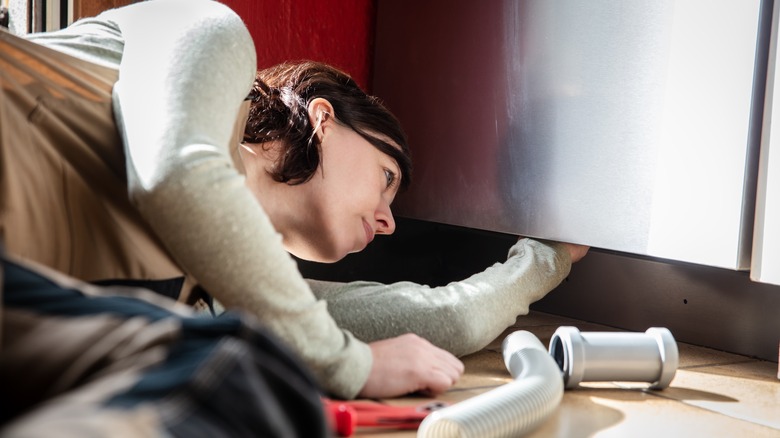Common Mistakes To Avoid When Installing A Dishwasher
So, you've bought yourself a shiny new dishwasher. Good for you! Contrary to popular belief, most certified models of this appliance actually save water and energy compared to handwashing and of course, are very convenient for cleaning dishes and even home decor items. If you've decided to go the self-installation route, know that getting a dishwasher running on your own is fairly easy, but there are a few common mistakes DIY-ers find themselves making — wrong placement, taking the wrong measurements, bad drain and water line connections, forgetting to add a shutoff valve, not keeping the dishwasher level, and finally, skimping on the installation kit.
The first issue most installers have is with the placement. Before buying a new dishwasher, you should carefully select the best place in your kitchen for it. Since your dishwasher will likely be connected directly to the plumbing in your kitchen sink, that spot should be close to the sink for convenience and to save costs. You should also avoid measuring mistakes before getting your new appliance. Be sure to get the right height, width, and depth of the space you plan to fit the dishwasher. Also, ensure there is enough open space in front of it for the door to open easily to avoid inconvenience every time you use it. You might need to uninstall the old dishwasher to get accurate measurements for the replacement.
Avoid key installation errors: plumbing, leveling, and kits
Many DIY-ers aren't plumbers in their spare time, which is why drain and water line mistakes are common. Some people even damage these lines accidentally, so you have to be careful. Ensure you have the correct size for the drain line and follow the manufacturer's instructions diligently. If this line is properly installed, you won't have to deal with your dishwasher clogging. Follow the manual for the water supply connection too. Always connect your water supply to the hot water line and make sure to put in a shutoff valve to control water flow. Check whether your dishwasher comes with compression fittings or if you need to use a joint compound to prevent leaks.
The next mistake to avoid is not keeping your dishwasher level.This can affect the drainage, causing dirty water to pool inside your machine. Or worse, the water can damage the gasket on the dishwasher's door, forcing you to change it. Dishwashers usually have at least two leveling legs which you can tweak easily with a spirit level and adjustable wrench. Finally, it's a good idea to buy the installation kit for your dishwasher even when you already have a kit from an old one. While you might be able to reuse some hardware from the old one, intake and connection sizes could vary from machine to machine, so it's better to have a kit and not need it, than to need it but not have it.

